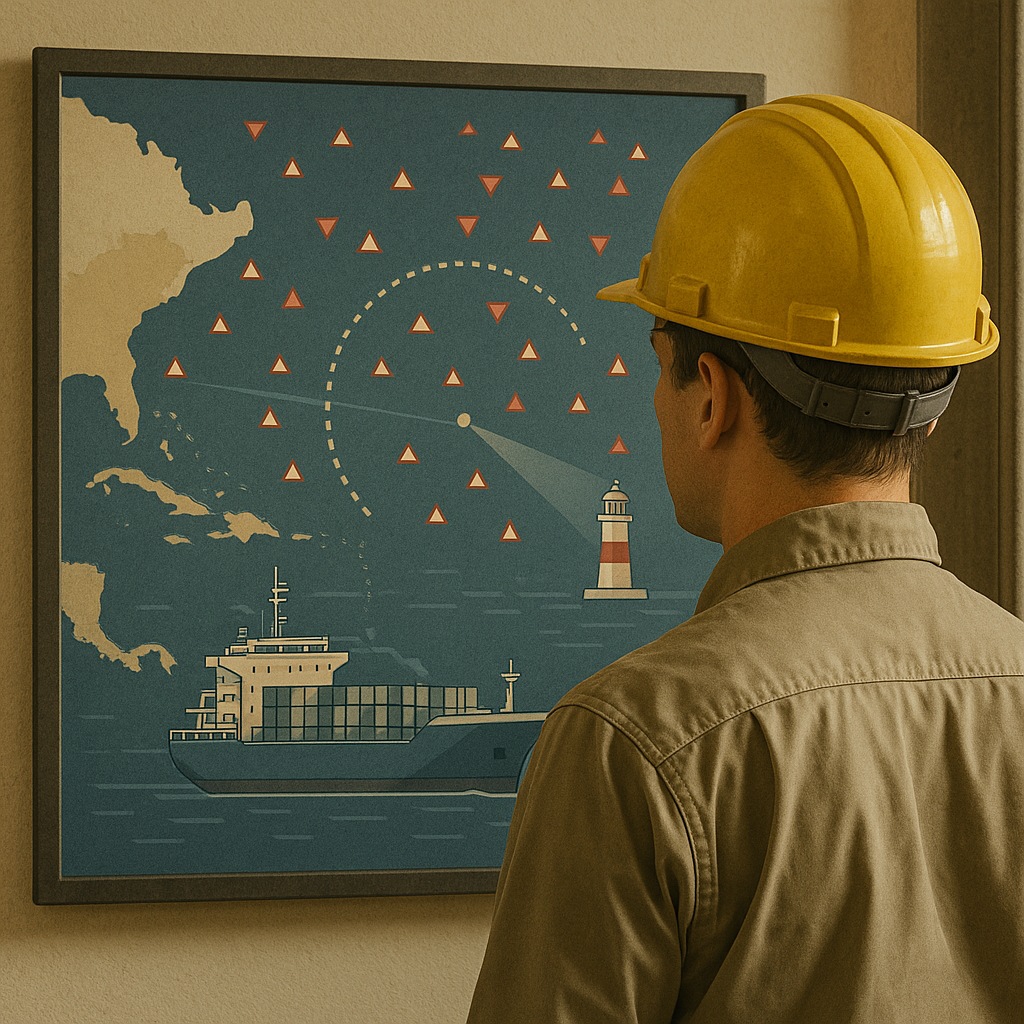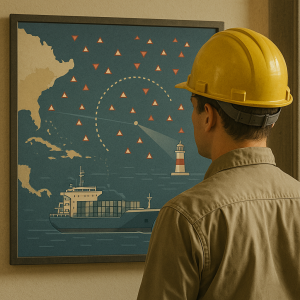Explore how vessel traffic management is transforming maritime safety, port efficiency, and environmental sustainability. This guide covers technologies, regulations, real-world examples, and future trends.
Why Vessel Traffic Management Matters in Modern Maritime Operations
Imagine a sky without air traffic control. Now imagine the world’s busiest sea lanes—like the Strait of Malacca or the English Channel—without any oversight. That’s the critical importance of vessel traffic management (VTM) in today’s global maritime industry.
With over 50,000 commercial ships navigating the seas at any given time, congestion, collisions, environmental risks, and security threats are real concerns. Vessel traffic management systems (VTMS) are the unsung heroes coordinating this enormous ballet of movement—ensuring that ports stay organized, ships don’t collide, and environmentally sensitive zones are respected.
As ports become smarter and ship design moves toward autonomy, VTM is no longer just about radar and radio—it’s about AI-driven analytics, real-time satellite tracking, predictive port scheduling, and green routing.
This article dives deep into how VTM works, why it’s essential, the technologies powering it, and where it’s heading next.
What Is Vessel Traffic Management?
Vessel traffic management refers to the systematic monitoring, coordination, and communication of ships in coastal, port, or congested water areas. It involves a mix of:
-
Shore-based Vessel Traffic Services (VTS)
-
Electronic Navigation systems (e.g., AIS, ECDIS)
-
Radar, sensors, and satellite data
-
Human operators and maritime pilots
VTM ensures navigational safety, traffic efficiency, environmental protection, and national security, particularly in high-risk zones like narrow straits, oil terminals, or military exclusion zones.
According to the IMO Resolution A.857(20), VTS is officially defined as a “service implemented by a competent authority, designed to improve the safety and efficiency of vessel traffic and to protect the environment.”
Core Components of Vessel Traffic Management
Shore-Based Vessel Traffic Services (VTS)
These are control centres located near major ports, straits, or waterways. A VTS may include:
-
Information Services: Ship position, weather, tides, and navigational warnings
-
Traffic Organization Services: Safe passage planning and separation schemes
-
Navigational Assistance Services: Particularly for vessels in distress or poor visibility
VTS operators are trained under IMO Model Course 3.03 and adhere to IALA standards (International Association of Marine Aids to Navigation and Lighthouse Authorities).
Automatic Identification System (AIS)
AIS transmits a ship’s identity, position, course, and speed to nearby vessels and coastal authorities. It is mandatory under SOLAS Chapter V, Regulation 19 for most commercial vessels.
Radar, Cameras, and Sensors
Modern VTM systems integrate coastal radar, infrared and optical cameras, and weather sensors. This multimodal detection helps track even non-cooperative vessels (those without AIS or intentionally dark).
Communication Infrastructure
Effective VTM depends on real-time communication via:
-
VHF radio channels
-
Digital selective calling (DSC)
-
Satellite communication (e.g., Inmarsat, Iridium)
-
GMDSS for distress alerts
Technologies Transforming Vessel Traffic Management
Big Data and Predictive Analytics
By processing AIS and sensor data, ports like Rotterdam and Singapore use predictive analytics to:
-
Forecast vessel arrival times
-
Manage berth allocations
-
Prevent bottlenecks
For example, Port of Hamburg’s SmartPORT Logistics platform optimizes traffic flows by integrating VTM with hinterland transport.
AI and Machine Learning
Artificial intelligence is used to:
-
Detect anomalies (e.g., drifting ships, abnormal speed)
-
Predict navigational hazards
-
Suggest optimal routes based on weather, congestion, or emissions
According to DNV’s 2023 Smart Shipping Review, AI-integrated VTM systems can reduce near-miss incidents by up to 35%.
Digital Twins and Port Simulation
Digital twins—virtual models of physical port environments—enable:
-
Scenario testing (e.g., emergency response, new route planning)
-
Training for VTS operators
-
Simulation-based optimization
Rotterdam’s PortXchange Synchronizer, initially developed by Shell and Maersk, is an example of digital twin integration with VTM data.
Satellite-Based Monitoring
Satellites such as Sentinel-1 (ESA) and commercial services like Spire or Orbcomm support global maritime awareness by covering areas beyond coastal radar range.
These are especially vital for tracking:
-
Illegal fishing vessels
-
Oil spill detections
-
Vessels disabling AIS in piracy or smuggling zones
Real-World Applications and Case Studies
Singapore Vessel Traffic Information System (VTIS)
One of the world’s busiest ports, Singapore’s VTIS manages over 1,000 ship movements daily in the Singapore Strait. The system integrates:
-
Coastal surveillance radars
-
Real-time AIS feeds
-
VHF communications
-
Decision-support systems
It serves as a model referenced in IMO model courses and IALA guidance documents.
Panama Canal Navigation and Scheduling
The Panama Canal Authority (ACP) uses advanced VTM to coordinate passage through its narrow locks. The system:
-
Assigns time slots and pilotage routes
-
Provides dynamic scheduling based on ship size and lock availability
-
Enhances canal efficiency and minimizes waiting times
Arctic Shipping and Ice Routing
As polar routes open due to melting ice, VTM in the Arctic Ocean is becoming critical. Russia’s Northern Sea Route Administration and Canada’s NORDREG (Northern Canada Vessel Traffic Services Zone Regulations) monitor vessels for ice conditions, environmental risk, and Indigenous community safety.
Regulatory and Safety Context
IMO and VTM
The International Maritime Organization (IMO) guides VTM through:
-
SOLAS Regulation V/12: Mandatory VTS participation
-
MSC Circulars on AIS and E-Navigation
-
GMDSS framework for communication
IALA Guidelines
The International Association of Marine Aids to Navigation and Lighthouse Authorities (IALA) provides:
-
VTS Training Manuals
-
Technical standards for radars, AIS base stations, and operator competency
-
Risk analysis models for implementing new VTS zones
Regional Agreements
-
EU VTM Directive (2002/59/EC): Establishes mandatory vessel monitoring systems and electronic reporting in EU ports.
-
Paris MoU and Tokyo MoU Port State Controls integrate VTM data to assess ship inspection priorities.
Challenges in Vessel Traffic Management
Cybersecurity Threats
As VTM systems become more connected, they are vulnerable to:
-
GPS spoofing
-
AIS manipulation
-
Malware on VTS networks
Notably, Lloyd’s Register and ABS have issued class notations and guidelines for cyber risk resilience, in line with IMO’s Resolution MSC.428(98).
Human-Machine Integration
VTS operators still play a key role. Striking the right balance between human judgment and AI support is crucial—especially in emergencies or unusual navigation behavior.
Lack of Standardization Across Regions
Not all VTS centres are created equal. Developing countries may lack:
-
Modern radar infrastructure
-
Trained operators
-
Legal backing for mandatory participation
This inconsistency can result in patchy maritime domain awareness, particularly in piracy-prone regions.
The Future of Vessel Traffic Management
Autonomous Shipping Integration
With autonomous ships on the horizon (e.g., Yara Birkeland, Mayflower Autonomous Ship), VTM systems will need to:
-
Communicate with AI navigation systems
-
Assign traffic lanes and adjust in real time
-
Create legal frameworks for “remote VTS oversight”
Global Maritime Traffic Harmonization
Expect greater efforts to unify data-sharing protocols and real-time interoperability between nations. The EU’s Maritime Single Window, IALA’s e-Navigation architecture, and UN’s Global Maritime Crime Programme are laying the groundwork.
Environmental and Climate Goals
Future VTM will support:
-
Emission-based routing (slow steaming, green corridors)
-
Sensitive habitat avoidance (e.g., whale migration zones)
-
Climate adaptation for sea-level rise or shifting weather patterns
Port-Centric Traffic Control
Ports will evolve into smart ecosystems, where VTM is part of an integrated platform including:
-
Berth planning
-
Customs clearance
-
Rail and truck coordination
The IAPH Smart Port Maturity Model already includes VTM as a core pillar.
Frequently Asked Questions
What is vessel traffic management (VTM)?
It’s the coordination of ship movements using VTS, AIS, radar, and communication technologies to improve safety, efficiency, and environmental protection.
Is vessel traffic service (VTS) mandatory?
Yes, in designated areas under IMO and national law. Ships must comply with VTS instructions, especially in congested ports or straits.
What’s the difference between AIS and VTS?
AIS is a shipborne transponder system, while VTS is a shore-based control and monitoring centre. AIS supports VTS but is not a replacement.
Do all ships need to use VTM systems?
Most commercial ships over 300 GT are required to use AIS and comply with VTS when entering controlled zones. Fishing and leisure vessels often have exemptions.
Can vessel traffic be controlled remotely?
Yes. Remote control centres can now manage port traffic and even interact with autonomous vessels using satellite data and AI systems.
Is VTM used for security and anti-piracy?
Yes. VTM supports national coast guards and navies in tracking suspicious activity and enforcing maritime security zones.
Conclusion
Vessel traffic management is the quiet conductor of maritime harmony. While ships, ports, and cargo steal the spotlight, it is VTM that ensures these elements move in sync—safely, efficiently, and sustainably.
In an era of digital transformation and increasing environmental scrutiny, the importance of modern, interoperable, and intelligent VTM systems cannot be overstated. Whether you’re a ship operator, port manager, student, or policymaker, understanding VTM is essential to navigating the future of global maritime transport.
Let’s not forget: A well-managed sea is a safer sea.
References
-
IMO. (2023). SOLAS Convention, Chapter V – Safety of Navigation. https://www.imo.org
-
IALA. (2024). VTS Manual & Guidelines. https://www.iala-aism.org
-
DNV. (2023). Smart Shipping Review. https://www.dnv.com
-
Port of Hamburg. (2024). SmartPORT Logistics Platform. https://www.hafen-hamburg.de
-
IAPH. (2023). Smart Port Maturity Model. https://www.iaphworldports.org
-
European Commission. (2023). Maritime Traffic Monitoring Directive 2002/59/EC. https://transport.ec.europa.eu
-
PortXchange. (2023). Synchronizer Platform. https://www.port-xchange.com
-
Lloyd’s Register. (2024). Cybersecurity Notations for Port Systems. https://www.lr.org
-
WMU Journal of Maritime Affairs. (2023). Human Factors in Vessel Traffic Services
-
UNCTAD. (2024). Review of Maritime Transport. https://unctad.org


